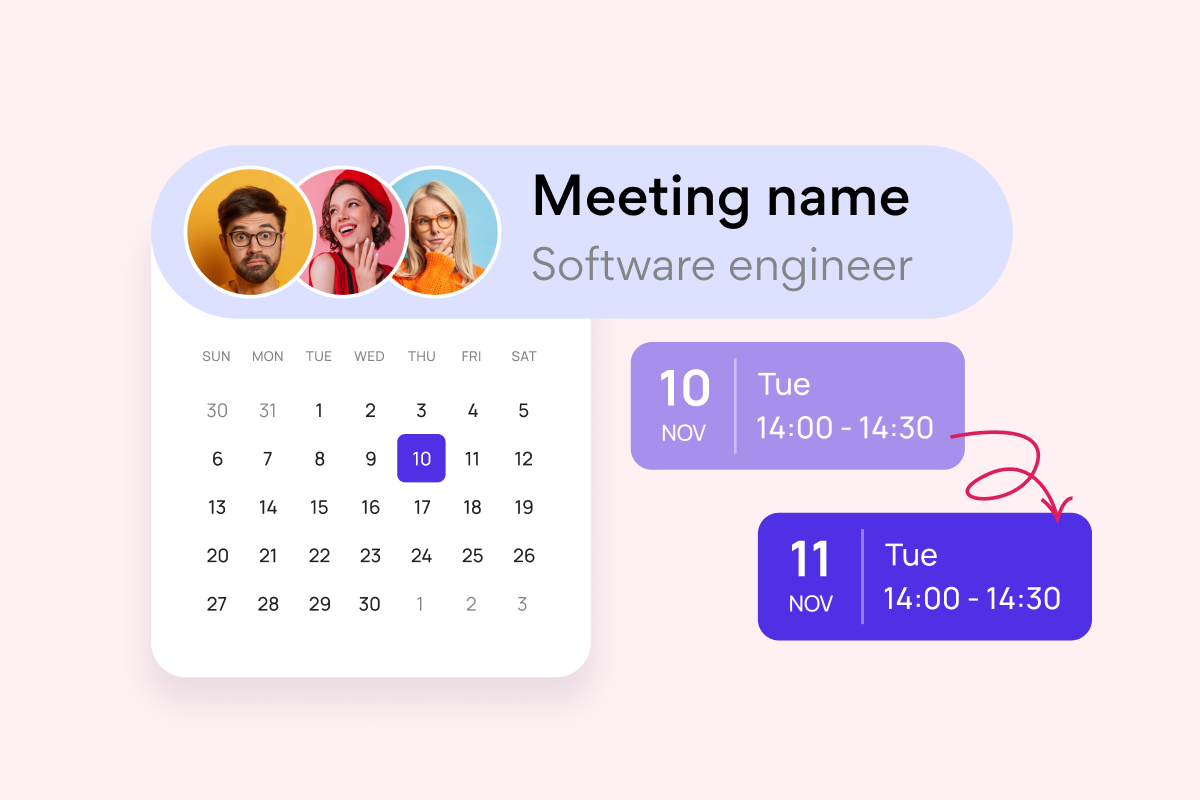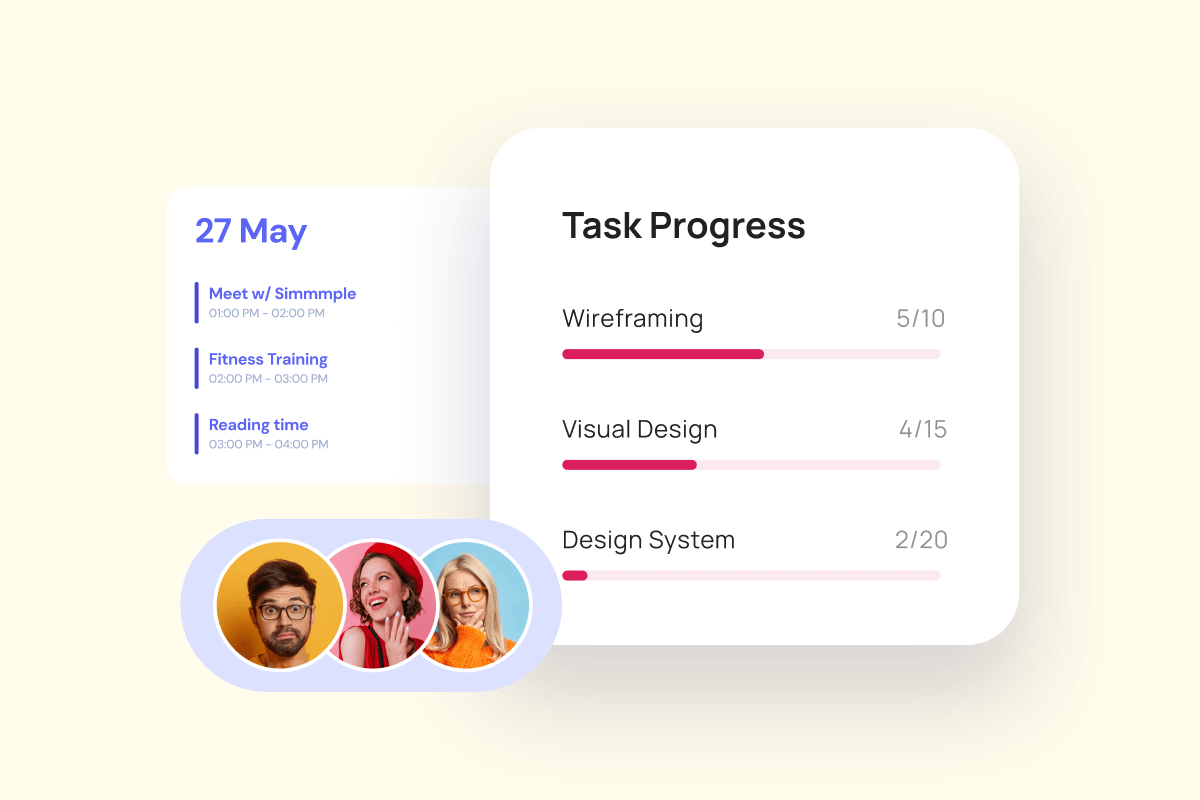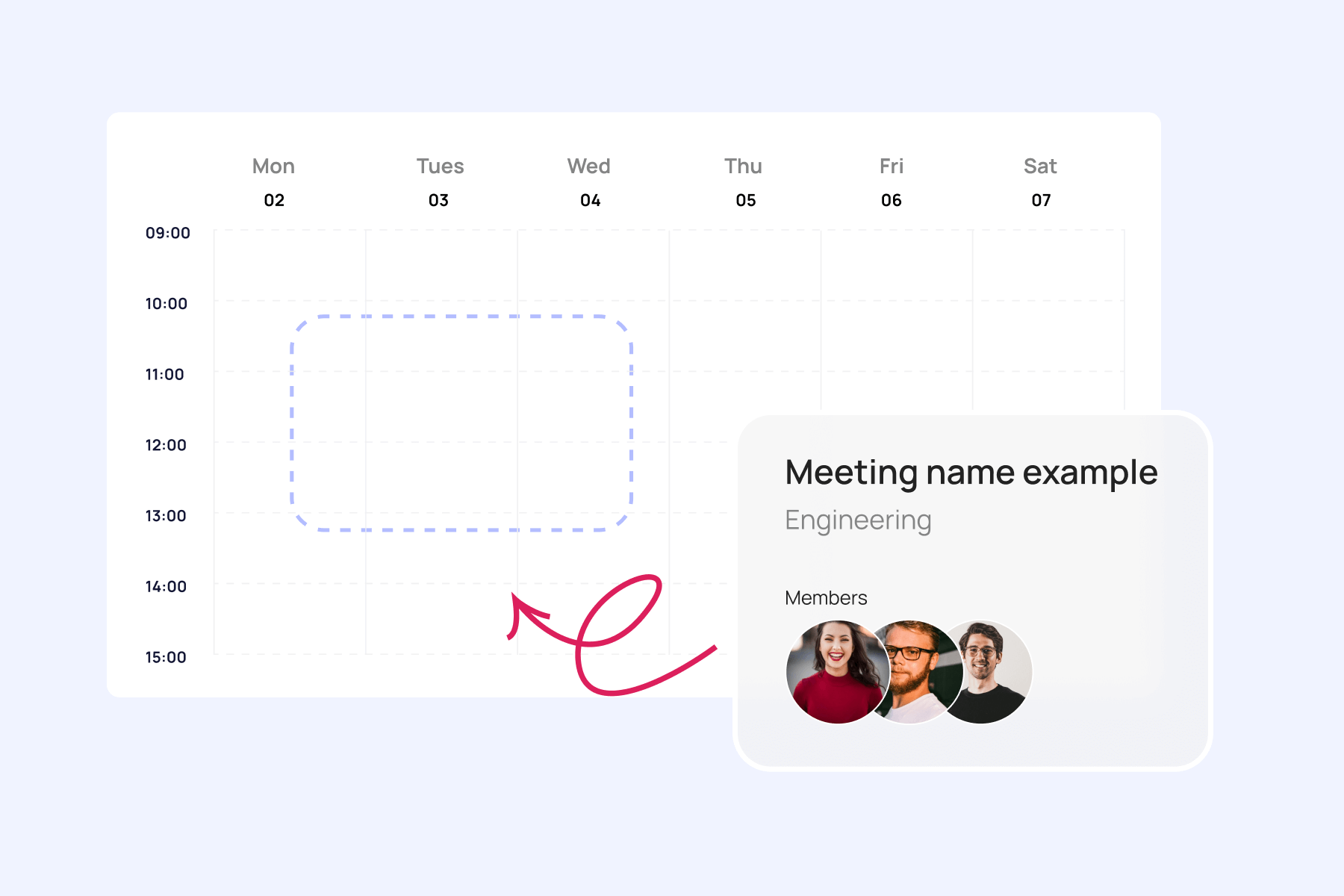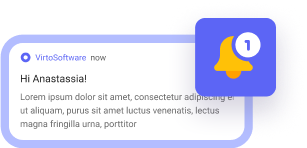With team members often spread across different locations, time zones, and even continents, organizations face unique challenges in maintaining cohesive, productive teamwork. The ability to collaborate seamlessly—regardless of physical location—has emerged as a competitive advantage for successful companies.
A well-crafted collaboration strategy does more than simply connect team members; it accelerates processes, boosts engagement, and significantly enhances overall productivity. When teams collaborate effectively, they share knowledge more efficiently, solve problems faster, and develop more innovative solutions. This leads to reduced rework, faster time-to-market, and ultimately, better business outcomes.
This article explores the fundamental elements of effective collaboration, proven strategies that drive success, and how digital tools—particularly VirtoSoftware solutions—can help implement collaboration best practices in today’s complex work environments.
What Is Effective Collaboration?
Effective collaboration is a deliberate, coordinated process of working together between people or teams to achieve a common result. It goes beyond simply occupying the same physical or virtual space or dividing tasks among team members. True collaboration represents a structured approach to collective work that maximizes the strengths of each participant while creating outcomes that exceed what any individual could accomplish alone.
Unlike casual “working together,” effective collaboration involves a strategic approach with intentional elements. It requires establishing clear roles for each participant, developing shared goals that align everyone’s efforts, maintaining transparent communication throughout the process, and fostering a high degree of mutual understanding between all involved parties. This deliberate structure creates an environment where creativity, productivity, and engagement can flourish.
👉 What is effective collaboration in the workplace? Effective collaboration in the workplace is the process where team members work together seamlessly to achieve common goals. It involves clear communication, mutual respect, and shared responsibility. When collaboration works well, diverse perspectives combine to create solutions better than what individuals could produce alone.
Key features of effective collaboration
Below are key features of effective collaboration:
- Open communication
Participants freely exchange ideas, discuss difficulties, and share feedback without fear of judgment. This transparency ensures that all perspectives are considered and potential issues are identified early. Team members feel comfortable expressing both creative concepts and concerns, creating a rich dialogue that improves decision-making.
- Mutual trust
No one is afraid to delegate tasks, admit mistakes, or ask for help. Team members believe in each other’s capabilities and intentions, which creates psychological safety. This foundation of trust allows for appropriate risk-taking, honest conversations, and genuine cooperation rather than competition.
- Clear roles and responsibilities
Everyone knows what they are responsible for and how their contribution affects the overall result. Well-defined roles prevent duplication of efforts, reduce confusion, and ensure accountability. Each team member understands not only their individual tasks but also how those tasks connect to the broader objectives.
- Aligned goals
The entire team is moving in the same direction and understands priorities. When goals are clearly articulated and shared, team members can make decisions that support the collective purpose rather than working at cross-purposes. This alignment creates momentum and reduces friction in the collaborative process.
- Flexibility
Participants adapt to change, help each other when needed, and find compromises. Effective collaboration acknowledges that plans may need to evolve and team members must be willing to adjust their approaches. This adaptability allows teams to overcome obstacles and capitalize on unexpected opportunities.
- Feedback and self-Analysis
The team regularly evaluates its processes and looks for ways to improve. Continuous improvement is built into the collaborative framework, with structured opportunities to reflect on what’s working well and what could be enhanced. This commitment to growth keeps collaboration dynamic and responsive to changing needs.
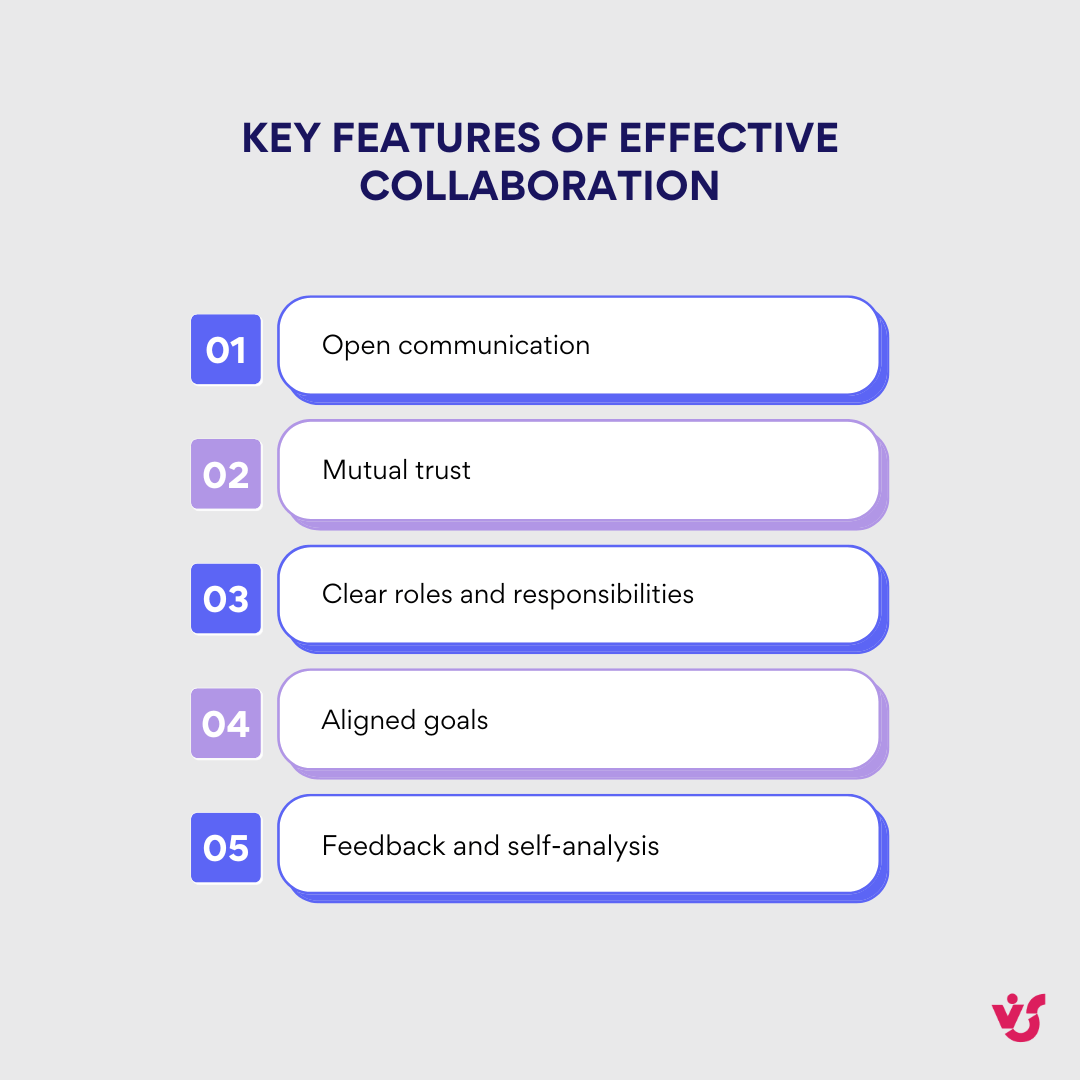
👉 What is the difference between collaborative strategies and collaboration strategies? There is no meaningful difference between “collaborative strategies” and “collaboration strategies” as both terms refer to planned approaches for enabling effective teamwork. The terms are used interchangeably in professional contexts, with both describing methods, tools, and frameworks designed to facilitate productive joint work between individuals or groups. Any perceived distinction would be purely semantic rather than substantive in organizational literature and practice.
Why Effective Collaboration Is Important for Business
This section explores how effective team collaboration drives business performance, examining its impact on key metrics, operational efficiency, customer satisfaction, and employee retention.
The role of team interaction in achieving business goals
When team members collaborate effectively, they create a synergy that propels the organization toward its goals more efficiently than individual efforts could achieve alone. Research from Deloitte shows that organizations with high collaboration index scores experience significant improvements across multiple business metrics, including a 41% increase in customer satisfaction, 34% improvement in product quality, and 27% increase in sales.
This powerful impact occurs because collaboration allows organizations to:
- Leverage diverse perspectives and expertise to solve complex problems
- Distribute workloads optimally according to team members’ strengths
- Create alignment around shared goals and priorities
- Adapt more quickly to changing market conditions
As Stanford University research demonstrates, people working collaboratively stick with challenging tasks 64% longer than those working independently, showing how collaboration enhances persistence and resilience in the face of obstacles.
How strategies for effective collaboration affect key business metrics
The impact of effective collaboration on business performance can be measured across several key operational metrics. Let’s examine the specific ways collaboration enhances these critical business indicators:
Increased speed of task execution
When project participants clearly understand their areas of responsibility, quickly receive necessary information, and efficiently coordinate their actions, projects move forward at an accelerated pace. This speed advantage comes from:
- Reduced decision-making bottlenecks as team members know who has authority for different decisions
- Faster information flow through established communication channels
- Parallel processing of interdependent tasks through coordinated workflows
- Quicker resolution of obstacles as they emerge
For example, software development teams using collaborative agile methodologies typically deliver working features 5% more productively than teams using less collaborative approaches, according to studies in the software industry.
Reduced number of errors and misunderstandings
Clear roles and regular synchronization meetings minimize the risk of misunderstandings, which is especially critical in development, marketing, and customer service functions. Benefits include:
- Fewer costly rework cycles due to miscommunication
- Reduced project delays caused by misaligned expectations
- Lower risk of quality issues reaching customers
- More consistent implementation of standards and best practices
Healthcare teams demonstrate this principle clearly—when healthcare providers collaborate effectively, they significantly reduce errors and improve patient outcomes, with research showing that collaboration accounts for up to 60% of job satisfaction variance among healthcare professionals.
Improved customer experience
When all departments work together seamlessly, they provide clients with a unified, predictable, and high-quality experience that directly impacts loyalty and sales. This occurs because:
- Customer journeys are more coherent when teams collaborate across touchpoints
- Product development better reflects customer needs when sales and support teams share insights
- Service issues are resolved more efficiently when departments coordinate their responses
- Brand messaging remains consistent when marketing and sales align their communications
Starbucks’ rapid expansion in the 1990s illustrates this principle—by fostering collaboration between various team members around the mission of selling an experience rather than just coffee, they created a consistent customer experience that fueled their growth from 84 stores to a global brand.
Increased employee engagement and retention
Employees who work in well-organized, collaborative teams feel supported, see the value of their contributions, and are more likely to remain with the company. According to research cited by Rocket.Chat, 33% of employees report increased loyalty when they can collaborate effectively. This engagement stems from:
- Greater sense of belonging and purpose through shared achievements
- Enhanced opportunities for learning from peers with complementary skills
- More meaningful work relationships that support professional development
- Increased psychological safety within supportive team environments
The Bureau of Labor Statistics notes that the median tenure at companies has declined from 4.6 years in 2014 to 4.2 years in 2018 (as cited in the LumApps article). With the average cost to replace an employee ranging from six to nine months of their salary (according to SHRM), improving collaboration represents a significant opportunity to reduce turnover costs.
👉 What is collaborative strategy? A collaborative strategy is a deliberate approach to working with others that maximizes collective strengths and resources to achieve shared objectives. It involves establishing structured processes for joint decision-making, information sharing, and coordinated action across individuals, teams, or organizations. Collaborative strategies typically include defining clear roles, setting up transparent communication channels, implementing appropriate technology platforms like Virto Calendar or Kanban boards, and creating accountability mechanisms that foster trust.
When collaboration fails: Examples of project breakdown
Without effective collaboration, even promising projects can falter or completely collapse. Consider these common scenarios:
- Product launch delays: A technology company developing a new device fails to coordinate between engineering, marketing, and sales teams. Engineers build features users don’t want because they weren’t included in customer research conversations. Marketing creates materials that misrepresent the product’s capabilities because they weren’t properly briefed on technical limitations. The resulting product launches six months late, misses market opportunities, and fails to meet sales targets.
- Customer service breakdowns: A customer contacts a company about an issue and receives different, contradictory information from various departments. The support team says one thing, the billing department another, and the product specialist a third. Without collaboration between these functions, the customer receives a fragmented, frustrating experience that damages brand loyalty and potentially leads to lost business.
- Costly duplicated efforts: Two departments within an organization unknowingly work on solving the same problem without communicating with each other. They invest significant resources developing separate solutions, only to discover the duplication in late stages. The company wastes time, money, and employee energy that could have been avoided through basic collaborative practices.
- Cross-team conflicts: Marketing promises features to customers that the development team hasn’t approved or scheduled. When customers expect these features and they aren’t delivered, the sales team blames marketing, marketing blames development, and development blames management for unrealistic deadlines. These finger-pointing cycles create toxic workplace culture and ultimately impact business performance.
The reality is clear: collaboration isn’t optional—it’s essential for organizational success. Companies that cultivate effective collaboration gain significant advantages in operational efficiency, customer satisfaction, innovation, and employee retention, all of which translate directly to improved business outcomes.
Effective Strategies for Team Collaboration
Successful collaboration requires deliberate planning, consistent execution, and the right supporting infrastructure. In this section, we’ll explore six proven approaches that transform group work into true collaboration, examining specific techniques and tools that create the foundation for high-performing teams.
Defining a common goal and transparent metrics
Without a clear understanding of the common goal, teams inevitably waste resources on less important tasks, move in conflicting directions, and produce inconsistent work. Effective collaboration begins with establishing objectives that everyone understands and supports.
The common goal should be explicitly voiced, documented, and accepted by all team members. Using the SMART framework ensures goals are Specific, Measurable, Achievable, Relevant, and Time-bound, providing clarity that focuses effort and measures progress.
Regular synchronization meetings (daily or weekly) help teams stay aligned, while status updates in shared channels like Teams or Slack keep everyone informed of key developments. This transparency helps teams prioritize effectively and identify deviations from the plan before they become significant problems.
Clear distribution of roles
When team members don’t understand their responsibilities, important tasks fall through the cracks while others get duplicated. Role clarity eliminates confusion and creates accountability.
Roles shouldn’t be assigned informally through assumptions (“it seems he’s responsible for this”) but should be documented and explicitly agreed upon. A RACI matrix provides a structured approach:
- Responsible: Who performs the task
- Accountable: Who is ultimately responsible for the result
- Consulted: Who needs to be consulted during the process
- Informed: Who needs to stay informed of progress
This clarity becomes particularly crucial for cross-functional teams where representatives from different departments must coordinate effectively toward shared outcomes.
Shared communication tools
Effective collaboration depends on unified communication channels that everyone consistently uses. Teams that scatter communication across multiple platforms create information silos and misalignment.
Tools like Microsoft Teams, Slack, and Google Chat create centralized environments where discussions, files, tasks, and meetings coexist in a single space. All team members should have open access to core project materials including documentation, plans, guides, and activity logs.
This unified approach prevents isolation, eliminates “information holes,” and accelerates processes by ensuring everyone works from the same information base.
Visual task management
Visualizing work dramatically improves team coordination and individual accountability. Kanban boards through platforms like Microsoft Planner, Trello, Virto Kanban Board App for Microsoft Teams, or Asana create transparency around who’s doing what.
Visual management allows teams to:
- Track overall progress at a glance
- See individual contributions and workloads
- Identify bottlenecks and constraints quickly
- Prevent duplication of effort
This approach empowers team members to independently select tasks from the common pool based on priorities and provide visible status updates as work progresses.
Use a shared calendar
A team calendar serves as a critical coordination tool. Without it, scheduling conflicts become inevitable, meetings get missed, and deadlines slip past unnoticed.
Outlook Calendar, Teams Calendar, or specialized solutions like Virto Calendar App provide significant advantages:
- A unified view of time commitments across the team
- Visibility into colleague availability
- Automated reminders and color-coded categorization
- Integration with specific projects, clients, or workstreams
These shared calendaring practices become especially valuable for distributed and hybrid teams working across different locations and time zones.
👉 Learn more about shared calendars here:
- 11 Best Shared and Collaborative Calendar App for Business Needs
- How to Create a Shared Calendar in Microsoft Teams: Guide, Tips, Security Issues
- Best 5 Shared Calendars for SharePoint Online
- Simplify Collaboration with Shared Calendars in Microsoft 365 and SharePoint
- How to Add Microsoft Planner Tasks to a Shared Calendar
- Guide to Setting Up a Shared Calendar in Microsoft Office 365
Regular retrospectives
Retrospectives form the cornerstone of a continuous improvement culture. These structured reflections aren’t just about summarizing results—they create space for honest discussions about team dynamics and processes.
Effective retrospectives examine:
- What worked well that should continue
- What could be improved in future iterations
- Specific challenges in communication, management, or task distribution
Conducting regular retrospectives (typically every 2-4 weeks or at project milestones) helps teams build trust, adapt processes to real-world conditions, and continuously refine their collaboration approaches. Using structured templates like “Start-Stop-Continue” or “4Ls” (Liked, Learned, Lacked, Longed For) helps focus these discussions on actionable insights.
How do you build effective collaboration?
Building effective collaboration requires intentional design of both team processes and supporting infrastructure. By implementing these six strategies—clear goals, defined roles, unified communication, visual management, shared scheduling, and regular reflection—teams create the conditions for productive collaboration rather than hoping it emerges organically. Each element reinforces the others, creating a system where information flows freely, responsibilities are clear, and continuous improvement becomes part of the team’s DNA.
👉 So, how to collaborate effectively? To collaborate effectively, establish clear goals and roles while maintaining open communication channels that foster transparency and trust. Implement shared digital workspaces like Virto Calendar or Kanban boards that provide visual tracking of progress and centralize important information. Practice active listening and respect diverse perspectives, addressing conflicts promptly and constructively. Schedule regular check-ins to maintain alignment and adjust strategies as needed. Finally, leverage appropriate technology solutions that integrate with your existing workflow while promoting accountability through shared responsibility for outcomes.
Key Skills for Effective Collaboration
Even with perfect processes and cutting-edge collaboration tools, teams ultimately depend on the human element—the interpersonal skills that enable productive interaction despite differences in background, thinking styles, or perspectives. This section explores the essential soft skills that transform groups of individuals into cohesive, high-functioning teams, and provides practical approaches for developing these capabilities.
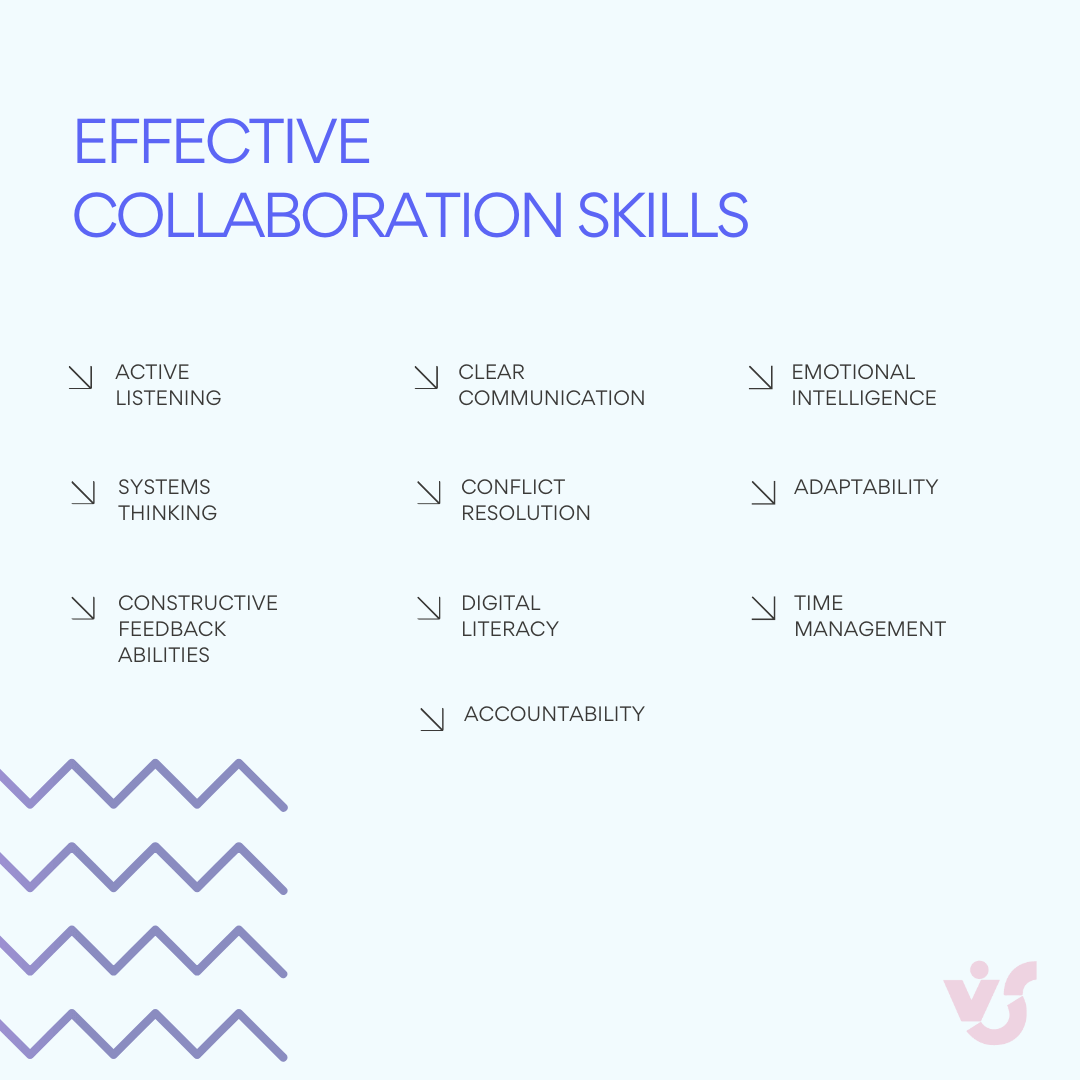
The foundation of collaborative success
Effective collaboration is fundamentally built on interpersonal skills that facilitate productive engagement among diverse team members. Well-developed soft skills enable teams to not only accomplish shared tasks but also prevent conflicts, maintain an atmosphere of trust, and achieve the synergy that produces results greater than what individuals could achieve alone.
Essential collaborative skills
Let’s look at a few key collaborative skills in more detail below:
Empathy
The ability to understand another person’s perspective creates the foundation for meaningful collaboration. When team members can genuinely put themselves in their colleagues’ positions, they gain insight into motivations, emotional states, and constraints, especially critical during complex cross-functional work.
Empathy significantly reduces friction and conflict by creating understanding before judgment. Team members who demonstrate empathy strengthen the sense of psychological safety and belonging that enables genuine collaboration rather than merely coordinated individual efforts.
Active listening
Hearing differs fundamentally from listening. Active listening involves fully concentrating on the speaker, understanding their message, responding thoughtfully, and remembering key information. This practice includes asking clarifying questions, paraphrasing to confirm understanding, and maintaining focus on the speaker rather than preparing your response.
Teams that practice active listening avoid costly misunderstandings, capture important nuances, and make team members feel valued—all of which substantially improve the quality and outcomes of communication.
Flexibility of thinking
Cognitive flexibility—the willingness to consider alternative viewpoints and adapt to changing conditions—proves especially valuable in cross-functional settings where diverse perspectives must be integrated. Team members with mental flexibility find it easier to:
- Consider multiple approaches to problems
- Revise established work methods when necessary
- Find constructive compromises that incorporate diverse needs
- Adapt quickly when circumstances change
This flexibility helps teams navigate complexity and uncertainty without becoming stuck in rigid thinking patterns.
Responsibility
Personal accountability forms the bedrock of team trust. When team members consistently fulfill commitments without needing reminders or supervision, the entire collaborative process becomes more transparent and reliable.
Clear ownership of tasks and outcomes eliminates ambiguity about who’s responsible for what, reducing the “diffusion of responsibility” that often undermines team performance. Responsible team members understand that their reliability directly impacts others’ ability to succeed.
Clear communication
The ability to articulate thoughts precisely—whether verbally or in writing—dramatically affects collaboration quality. Effective communicators save the team significant time by reducing the need for clarifications, revisions, and additional explanations.
This skill becomes particularly crucial in remote and hybrid work environments where non-verbal cues may be limited and communication happens predominantly through digital channels. Clear communication ensures context and agreements travel accurately across time and distance.
Conflict management
Healthy teams don’t avoid conflicts—they manage them constructively. The ability to address problems directly without resorting to personal attacks maintains psychological safety while still addressing important issues.
Effective conflict management involves:
- Focusing on interests rather than positions
- Seeking win-win solutions that address underlying needs
- Addressing issues promptly before they escalate
- Maintaining respect throughout difficult conversations
Teams skilled in conflict management convert potential disruptions into opportunities for deeper understanding and innovative solutions.
Feedback skills
Regular, well-delivered feedback accelerates individual and team development. This critical skill involves both giving and receiving constructive input aimed at improvement rather than criticism.
Effective feedback is:
- Specific rather than general (“When you interrupted during the client presentation” rather than “You’re always disruptive”)
- Timely, delivered close to the relevant event
- Focused on behaviors that can be changed, not on personality
- Balanced between reinforcing strengths and addressing development areas
Organizations with strong feedback cultures demonstrate higher performance, innovation, and adaptability compared to those where feedback is avoided or poorly delivered.
Developing collaborative skills
These essential skills don’t develop automatically—they require deliberate cultivation through:
- Practice: Active participation in diverse team projects with varied dynamics provides natural opportunities to exercise collaborative skills. Look for cross-functional initiatives, task forces, or special projects that involve working with different colleagues.
- Learning: Formal development through workshops, coaching sessions, and structured training can accelerate skill development. Many organizations now offer specific programs focused on effective collaboration skills as part of their talent development strategy.
- Feedback: Regular retrospectives and one-on-one conversations provide opportunities to reflect on collaboration practices and receive specific input on personal strengths and growth areas. Creating psychological safety is essential for this feedback to be effective.
- Digital tools: Modern collaboration platforms like Microsoft Teams, Planner, and Virto Kanban Board support transparent communication and workflow visibility, creating environments where these skills can be practiced consistently.
👉So, what are the most effective collaboration skills? The most effective collaboration skills include clear communication (both verbal and written), active listening that demonstrates genuine understanding of others’ perspectives, adaptability in adjusting to changing requirements and team dynamics, emotional intelligence to navigate interpersonal relationships, and conflict resolution abilities to address disagreements constructively. Additionally, time management, the capacity to give and receive feedback, digital literacy for using collaborative tools effectively, accountability for commitments, and systems thinking to understand how individual contributions affect the broader team goals are essential for successful collaboration in today’s cross-functional workplace environments.
Collaborative Strategies Examples: What Are Examples of Collaboration Strategies?
In this section, we’ll explore real-world examples of collaboration strategies that have delivered tangible results across different business scenarios.
These team collaboration strategies demonstrate how well-orchestrated teamwork can solve complex challenges, streamline processes, and deliver superior outcomes.
Marketing and Development teams work together on a new landing page
Scenario: A company launches an advertising campaign and wants to create a dedicated landing page for the offer. The development and marketing teams collaborate closely:
- Marketing: Creates the page structure, writes copy, provides visual references
- Development: Implements the design, sets up forms and integrations
- UX designer: Adapts the layout to optimize for user behavior
Strategies that worked:
- Creating a common channel in Microsoft Teams with tabs for tasks, layouts, and discussions
- Using a shared Kanban board to track stages (design, development, testing, launch)
- Maintaining a shared calendar with deadlines for stages and planned sprints
- Conducting regular 15-minute sync meetings at the beginning of each day
Result: The landing page launched on time with minimal errors, and campaign efficiency exceeded expectations due to well-thought-out structure and user experience.
Cross-functional interaction during product launch
Scenario: Launching a new SaaS product requires coordination across multiple departments:
- Development: Responsible for building the product itself
- Marketing: Prepares positioning, copy, and promotional materials
- Sales: Collects feedback and develops pricing strategy
- Support: Creates FAQ documentation and training materials
Strategies that worked:
- Using Virto Kanban Board App in Teams—making all tasks and statuses visible in a single space
- Holding regular weekly meetings with representatives from all departments
- Creating a group calendar in Outlook/Teams to coordinate key milestones: soft launch, marketing emails, website launch, etc.
- Establishing transparency through shared access to documents and presentations stored in SharePoint
Result: The launch proceeded smoothly thanks to full synchronization. All materials were ready on time, and the team avoided duplicating efforts.
Onboarding new employees with HR, IT, and line manager collaboration
Scenario: Successfully integrating a new employee requires participation from several departments:
- HR: Prepares documentation, organizes welcome sessions, adds employees to company systems
- IT: Configures equipment and access permissions
- Manager: Introduces tasks, team members, and assigns a mentor
Strategies that worked:
- Using an onboarding process template in Microsoft Planner
- Clearly assigning responsibility for each stage: HR for registration, IT for technology setup, and managers for process integration
- Creating a shared calendar with scheduled meetings and deadlines
- Storing all onboarding materials in a centralized SharePoint folder accessible to the new employee
Result: The employee began performing productive tasks within the first week. All processes were coordinated in advance, eliminating overlaps and minimizing lost time.
Client management involving sales, support, and legal teams
Scenario: The company works with a large client where it’s crucial to simultaneously:
- Extend the contract (sales team)
- Provide high-level support (technical support team)
- Navigate legal formalities (legal team)
Strategies that worked:
- Using Virto Calendar App to synchronize meetings between representatives of all parties
- Creating a shared Kanban board for tracking customer commitments: contract renewal, implementation changes, support tickets
- Storing all correspondence and documentation in a secure SharePoint group
- Conducting monthly retrospectives on customer interactions
Result: The client reported high satisfaction with the transparency and responsiveness. The coordinated approach minimized legal risks and ensured consistently high service levels.
These examples highlight several common threads in effective collaboration:
- Unified communication channels that bring together all relevant information and participants
- Visual task management that makes progress and responsibilities clear to everyone
- Shared calendars that align activities and deadlines across teams
- Regular synchronization meetings that prevent miscommunication and resolve issues early
- Centralized document repositories that ensure everyone works from the same information
👉 What are the most effective collaboration strategies? The most effective collaboration strategies include establishing clear goals and responsibilities, creating transparent communication channels, leveraging visual management tools like Kanban boards, implementing a centralized information system, and fostering a culture that values diverse perspectives and shared accountability. Organizations that excel at collaboration typically combine these approaches with the right digital tools that integrate with existing workflows, enabling teams to coordinate seamlessly regardless of physical location or departmental boundaries.
Barriers to Effective Collaboration and How to Overcome Them
Even the most committed teams face obstacles to successful collaboration. Understanding these barriers and implementing strategic solutions is essential for organizations seeking to harness the full power of teamwork. In this section, we’ll explore the most common collaboration challenges and provide practical approaches to overcome them, drawing on research and real-world experience.
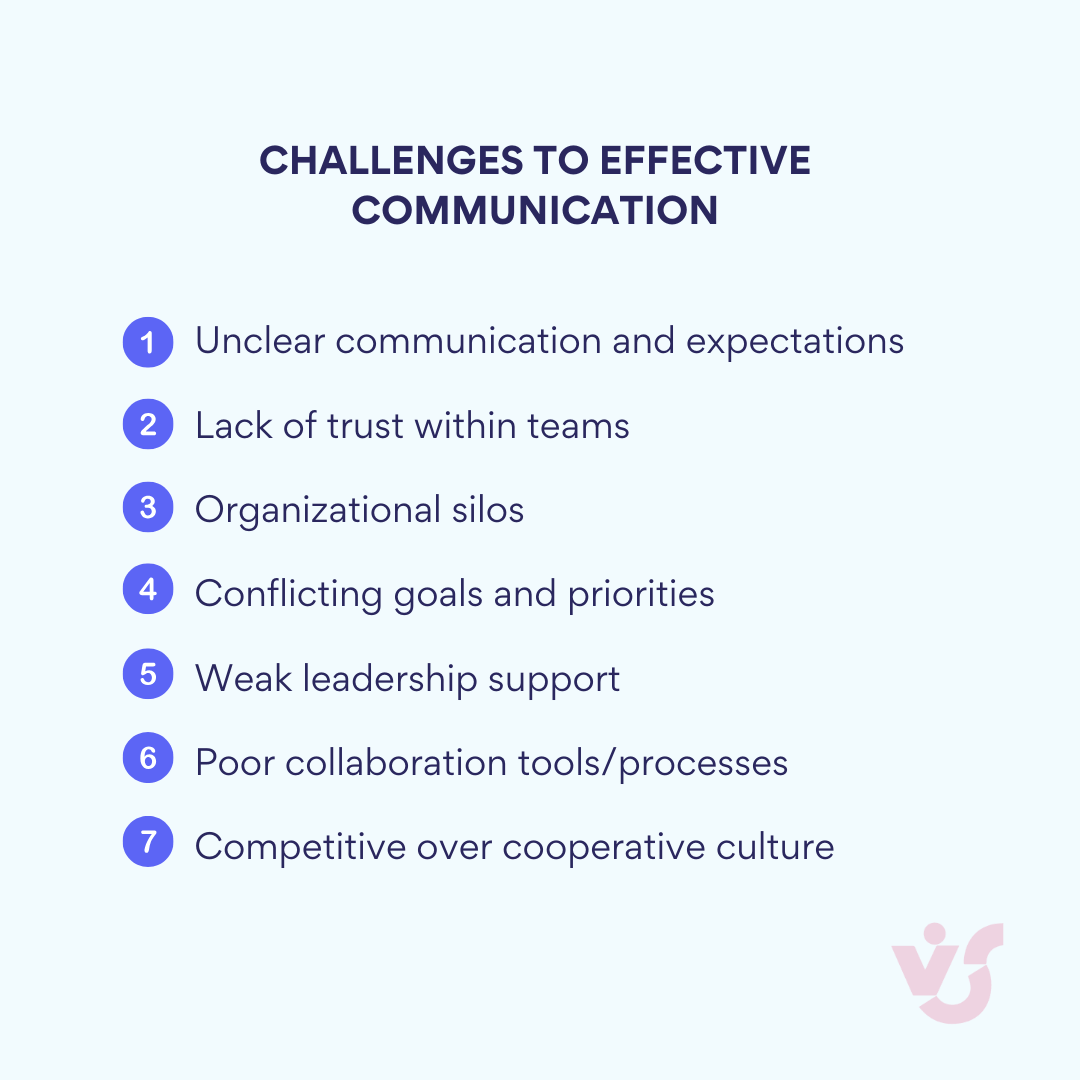
Disparate tools and communication platforms
Problem: When employees use different communication channels (email, instant messengers, calls, Google Docs, local files), important information gets lost, discussions are duplicated, and decisions go unrecorded. This fragmentation creates information silos and reduces transparency.
Solutions:
- Choose a single environment for communication and task management, such as:
- Microsoft Teams as a hub for communication, calls, file sharing, and integration with Planner, Outlook, and SharePoint
- Virto Kanban Board App for visual display of tasks directly inside Teams
- Centralized file and document storage (for example, in SharePoint)
- Establish communication protocols that specify which tools to use for different purposes (e.g., instant messaging for quick questions, video calls for complex discussions)
- Record all decisions, links, and documents in one space accessible to the entire team to create a single source of truth
Conflict of goals and priorities between departments
Problem: Different departments naturally have different priorities—marketing wants to launch campaigns faster, while IT focuses on security; sales targets profit, while legal emphasizes compliance. Without alignment, these differences cause conflicts and slow down progress.
Solutions:
- Formulate common project goals and transparent KPIs agreed upon by all participants at the start of any cross-functional initiative
- Use frameworks like OKR or SMART goals to establish common guidelines that connect departmental objectives to broader organizational aims
- Appoint a coordinator or project owner responsible for synchronizing priorities between departments and addressing conflicts when they arise
- Create a cross-functional steering committee for major initiatives that meets regularly to align priorities and resolve potential conflicts
Lack of trust and motivation
Problem: Team members may not feel valued in the project, might be afraid to share ideas, or appear indifferent to the team’s results. This is especially prevalent in distributed or cross-functional teams where personal relationships are less developed.
Solutions:
- Foster a culture of openness and respect by encouraging the exchange of opinions and creating a psychologically safe environment for dialogue
- Hold regular meetings with feedback opportunities where team members can express challenges without fear of judgment
- Publicly recognize team members’ achievements to reinforce the value of individual contributions
- Involve everyone in collaborative decision-making so that team members feel their input matters
- Implement team-building activities that help build interpersonal connections beyond work tasks
Overload of individual participants and uneven distribution of tasks
Problem: When one employee does the work of three while others are overloaded with internal tasks and cannot participate in teamwork on time, it leads to burnout, resentment, and decreased efficiency.
Solutions:
- Implement transparent task distribution with clear responsibilities and deadlines that everyone can see
- Use process templates where roles and stages are defined in advance to avoid imbalanced workloads
- Conduct regular retrospectives to identify overloads early and redistribute responsibilities
- Visualize team workload using tools such as Virto Kanban Board or Planner to make capacity constraints visible
- Monitor activity and involvement through reports and calendar checkpoints (sync meetings, status updates)
- Train managers to recognize signs of burnout and empower them to adjust workloads accordingly
Lack of clear instructions and workflows
Problem: When teams don’t know where to start, how to delegate tasks, or what the requirements for success are, it leads to chaos, duplication of effort, or tasks “falling through the cracks.”
Solutions:
- Develop and use task templates and project blueprints so teams don’t need to reinvent the wheel with each new initiative
- Create a knowledge base or instructions in OneNote or SharePoint that team members can reference
- Assign mentors within the team who can be contacted for clarification when processes are unclear
- Implement transparent checklists and status updates to track progress and ensure nothing is overlooked
- Establish clear decision-making frameworks (like RACI matrices) that specify who is Responsible, Accountable, Consulted, and Informed for each task
Financial barriers to collaboration
Research from the International Journal of Integrated Care highlights that financial constraints significantly impact the effectiveness of collaboration, particularly in healthcare settings. A nationwide survey of 153 integrated care initiatives in Switzerland found that financial barriers can completely negate the benefits of collaboration on patient care improvements.
Problem: Limited budgets, conflicting financial incentives across departments, and concerns about equitable resource distribution can prevent effective collaboration even when all other elements are in place.
Solutions:
- Establish dedicated budgets for collaborative initiatives rather than expecting departments to absorb costs
- Create shared metrics for ROI that acknowledge both tangible and intangible benefits of collaboration
- Design financial incentives that reward collaborative efforts rather than just individual or departmental performance
- Implement transparent cost-sharing models for cross-departmental initiatives
The most successful collaborative teams recognize that barriers are inevitable but not insurmountable. With the right tools, processes, and leadership commitment, these challenges become opportunities to strengthen relationships and improve outcomes rather than reasons to retreat to organizational silos.
Explore VirtoSoftware’s Collaborative Tools
How Virto Kanban Board and Virto Calendar Improve Team Collaboration
As discussed, effective team collaboration requires tools that integrate seamlessly with existing platforms while providing specialized functionality for task management and scheduling. VirtoSoftware offers two powerful applications designed specifically for the Microsoft 365 ecosystem that enhance how teams work together. Let’s explore how these tools transform collaboration across organizations of all sizes.
Virto Kanban Board: Visual task management for dynamic teams
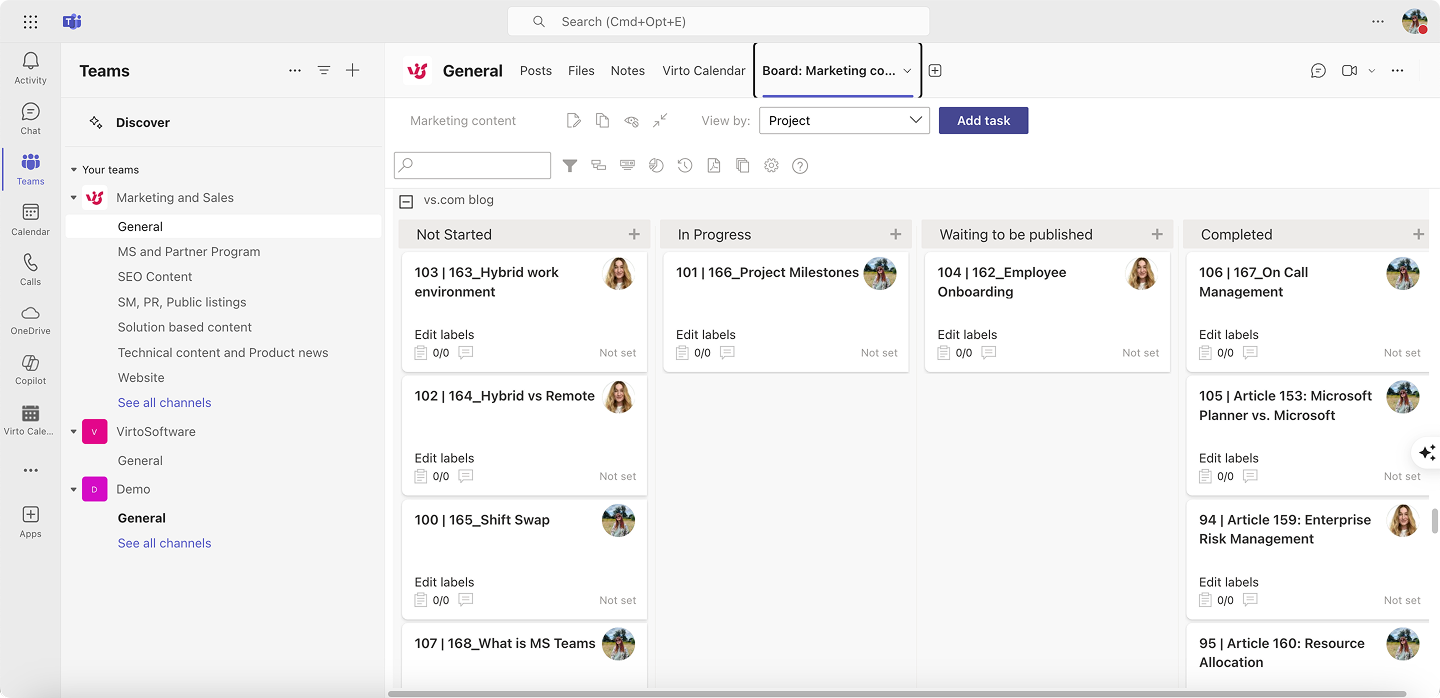
Below are Virto Kanban Board’s key features:
- Visual workflow management: The Virto Kanban Board transforms project management with a highly visual approach that adapts to your team’s specific workflow. The app offers:
- Customizable boards with swimlanes, categorization, color-coding, and subtasks that can be tailored to match your team’s unique processes
- Informative task cards displaying essential details including deadlines, assignees, and progress status
- Quick Start templates that allow teams to implement the board immediately without extensive setup
- Comprehensive project tracking: Beyond basic task visualization, Virto Kanban Board provides powerful tracking capabilities:
- Progress tracking that visualizes every stage of your project from inception to completion
- Planning and backlog management tools for prioritizing important tasks and organizing workflow
- Capacity and bottleneck management features to assess team velocity and adjust workloads
- Analytics and optimization: The app goes beyond simple task management with robust analytical features:
- Detailed reports and insights to aid in decision-making and adjustments
- Filters, WIP limits, and flexible charts for analyzing workflows and improving productivity
- Optimization tools that help teams identify and address inefficiencies
- Microsoft 365 integration: As a native Microsoft 365 application, Virto Kanban Board offers:
- Seamless integration with the Microsoft 365 ecosystem for a consistent user experience
- Cross-platform accessibility across MS Teams Web, Desktop, and Mobile App
- Direct integration with SharePoint lists, turning them into agile Kanban boards
Collaboration benefits
The Virto Kanban Board significantly enhances team collaboration through:
- Transparency: Visual representation of tasks creates shared understanding of project status and priorities
- Accountability: Clear task ownership and progress tracking keeps team members responsible for their commitments
- Reduced context switching: Managing projects directly within Microsoft Teams or SharePoint eliminates the need to switch between applications
- Streamlined communication: Task cards serve as centralized information hubs, reducing scattered conversations about work items
- Balanced workloads: WIP limits and capacity management prevent team burnout and identify bottlenecks before they impact deadlines
- Adaptability: Customizable boards allow teams to evolve their processes as projects and requirements change
Virto Calendar: Unified scheduling for coordinated teams

Below are Virto Calendar’s key features:
- Comprehensive calendar integration: Virto Calendar serves as a central scheduling hub by:
- Merging multiple calendars from different sources, centralizing planning and scheduling
- Managing unlimited calendars from Microsoft 365, Google, Apple, and more in one interface
- Providing diverse calendar views including Day, Year, Month, Week, Task, and multi-source options
- Powerful organization tools: The app enhances schedule clarity through:
- Effortless categorization with user-friendly color-coding options for calendar sources and events
- Streamlined planning with simplified event creation and scheduling features, including Teams meetings
- Centralized coordination for shifts, schedules, time off, and project milestones
- Integration across platforms: Virto Calendar creates a consistent scheduling experience through:
- Microsoft Teams integration, turning your Teams space into a scheduling hub
- SharePoint synchronization, blending document management and calendar efficiency
- Outlook/Exchange overlay, keeping your existing schedule accessible
- iCalendar consolidation from multiple sources for a complete view on any device
- Enterprise-ready security: Organizations benefit from:
- Enterprise-grade security and privacy features
- Full integration with Microsoft 365 security protocols
- Deployment options suitable for any industry or organization size
Collaboration benefits
Virto Calendar enhances team collaboration by providing:
- Unified visibility: Team members see all relevant schedules in one place, eliminating the need to check multiple calendars
- Improved coordination: Visual representation of overlapping schedules, resource availability, and project timelines prevents conflicts
- Simplified scheduling: Streamlined event creation reduces administrative overhead when planning team activities
- Cross-platform consistency: The same calendar information is accessible from SharePoint, Teams, or mobile devices, ensuring everyone has up-to-date information
- Resource optimization: Comprehensive booking views prevent double-booking of meeting rooms, equipment, or key personnel
- Enhanced accessibility: Mobile integration ensures schedule access on any device, anywhere, supporting remote and hybrid work environments
Common benefits for team collaboration
Both Virto apps deliver significant advantages that enhance team collaboration:
- Seamless platform integration: Both tools work within existing Microsoft 365 environments, ensuring adoption without disrupting workflows
- Centralized information management: Creating a single source of truth for project tasks or schedules reduces miscommunication and information silos
- Enhanced transparency: Visual representations of work and schedules improve team awareness and alignment
- Simplified administration: One license works across SharePoint, Teams, and Azure platforms, simplifying deployment and management
- Adaptability: Extensive customization options accommodate teams of different sizes, structures, and work styles
- Enterprise security: Both apps maintain Microsoft’s enterprise-grade security standards while extending functionality
Here’s a summary of key features and benefits of both apps:
| Feature | Virto Kanban Board | Virto Calendar |
| Core functionality | Visual task management for dynamic teams | Unified scheduling for coordinated teams |
| Key features | • Customizable boards with swimlanes • Progress tracking • Analytics and reporting • Capacity and bottleneck management • SharePoint list integration | • Multiple calendar integration • Diverse calendar views • Color-coding organization • Shift/schedule management • Teams meeting creation |
| Platform integration | • Microsoft Teams • SharePoint • Microsoft 365 ecosystem • Cross-platform accessibility | • Microsoft Teams • SharePoint • Outlook/Exchange • iCalendar sources |
| Collaboration benefits | • Visual transparency • Clear accountability • Reduced context switching • Streamlined communication • Balanced workloads • Process adaptability | • Unified schedule visibility • Improved coordination • Simplified scheduling • Cross-platform consistency • Resource optimization • Enhanced accessibility |
| Security | Enterprise-grade security integrated with Microsoft 365 | Enterprise-grade security with Microsoft 365 protocols |
| Common benefits | • Seamless platform integration • Centralized information management • Enhanced transparency • Simplified administration • Adaptability • Enterprise security | • Seamless platform integration • Centralized information management • Enhanced transparency • Simplified administration • Adaptability • Enterprise security |
Real-world applications
These tools adapt to various collaboration scenarios across industries:
- Agile development teams use Virto Kanban to prioritize backlogs, manage sprints, and track progress through customizable dashboards
- Marketing departments coordinate campaign launches with overlaid calendars showing content schedules, social media posts, and team availability
- Educational institutions track assignments, plan study sessions, and balance coursework across subjects
- Human resources teams optimize vacation scheduling with comprehensive tools for high-level resource planning
- Event planners execute corporate meetings and events with real-time visibility for both internal and external stakeholders
Explore More Real-World Applications of VirtoSoftware’s Tools
Virto Kanban Board and Virto Calendar represent powerful enhancements to Microsoft 365’s collaboration capabilities. By providing visual task management and comprehensive scheduling within familiar interfaces, these tools eliminate the friction that typically slows team coordination. With a shared focus on integration, customization, and accessibility, the Virto suite helps teams align their work regardless of complexity, size, or physical location.
Organizations seeking to improve their collaborative processes while maintaining their investment in Microsoft 365 will find these tools valuable additions to their digital workplace. The combination of visual task management and unified scheduling creates a foundation for more effective, transparent team collaboration in today’s complex work environments.
We invite you to explore these apps by scheduling a quick demo call or downloading free trial versions directly from our website.
Conclusion
To summarize, effective collaboration goes beyond simply working “together.” It is a strategically structured process that involves setting clear goals, distributing roles, fostering transparent communication, and ensuring shared responsibility. The foundation of productive collaboration lies in aligning teams across functions and locations, especially in hybrid and cross-functional environments.
Choosing a single platform for communication and task management, visualizing workflows, and enabling access to shared information are critical elements for achieving coordinated teamwork. These practices not only streamline processes but also foster innovation, reduce miscommunication, and enhance overall team efficiency.
We recommend utilizing VirtoSoftware solutions, such as the Virto Kanban Board App and the Virto Calendar App, to build a mature, flexible, and visually managed collaboration framework. These tools empower teams by simplifying task management, centralizing scheduling, and ensuring real-time updates, making them invaluable for modern organizations.
For further insights and best practices on improving team collaboration, we encourage you to explore additional resources on our blog:
